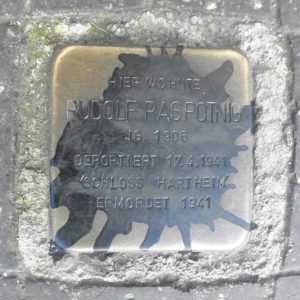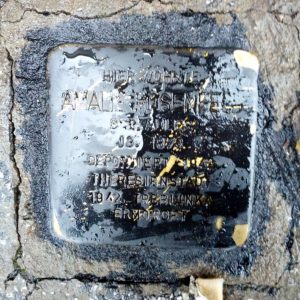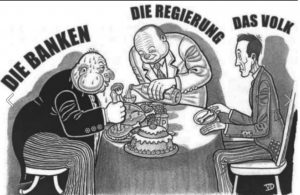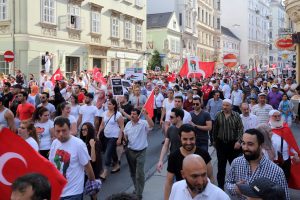In which forms can we observe hostility towards Jews in Austria? And what do the terms “secondary”, “traditional” and “Israel-related anti-Semitism” mean? Bernadette Edtmaier uses these three main types to outline historical and contemporary manifestations of anti-Semitism in Austria.
1945: anti-Semitism becomes a taboo
The break of the system in 1945 brought about far-reaching changes in how to deal with anti-Semitism in public. Shortly after the end of World War II, the Federal Republic of Germany (FRG) passed a normative “anti-Semitism ban”, making anti-Semitism a taboo in public. However, this did not necessarily mean that people gave up their anti-Semitic attitudes. Instead, many developed new communication strategies: overt anti-Semitism was usually replaced by forms of “detour communication”, such as subtle expressions, allusions or code words like “East Coast” or “Wall Street”.
“Detour communication” instead of overt anti-Semitism
In Austria’s public, however, overt anti-Semitism was expressed fairly unhindered immediately after 1945. This difference to the FRG is closely related to the so-called “victim thesis” with which Austria presented itself as the “first victim of Hitler”. This half-truth prevented a deeper investigation of Nazi ideology for decades. A public taboo – and thus the use of allusions and code words – only gradually began to emerge.
Secondary Anti-Semitism…
In reaction to the Nazi era, a new form of hostility towards Jews emerged after 1945: The term “secondary anti-Semitism” includes, for example, to deny or relativize the Holocaust, to blame the victim, accuse Jews that they would exploit the memory of the Holocaust for their own purposes, and in general to use subtle forms to communicate anti-Semitism. In Austria, the “victim thesis” particularly encouraged secondary anti-Semitism.
The “victim myth” only began to crumble in the context of the Waldheim Affair in 1986, when broad discussions about Austria’s Nazi past and co-responsibility started. A critical civil society emerged and demanded a proper examination of Austria’s Nazi past. Finally, in 1991, Chancellor Franz Vranitzky acknowledged that also Austrian citizens were responsible for Nazi-crimes.
… and its current dimensions
According to a partly representative survey (see infobox), there are now only a few people in Austria who play down the Holocaust.
However, other dimensions of secondary anti-Semitism have emerged in recent years: first, mockery of the Holocaust victims and second, attacks on Holocaust remembrance in public. In 2017, for example, a small group of law students shared a photo of a pile of ashes and marked it with the comment “Leaked Anne Frank nudes”. Anti-Semitic and racist verses in the songbooks of two nationalist fraternities caused two “songbook affairs” in 2018 and 2019. In one of the songs it says “In their midst comes the Jew Ben-Gurion: ‘Step on the gas, you ancient Germanic peoples, we’ll manage the seventh million’” [original: „Da trat in ihre Mitte der Jude Ben Gurion: ‚Gebt Gas, ihr alten Germanen, wir schaffen die siebte Million.‘“]. With this, descendants of the generation of perpetrators mocked Nazi victims with particularly repulsive cynicism. These cases were met with massive public rejection and criticism, but there were no far-reaching political or legal consequences for those responsible (such as the permanent resignation of political functions).


Attacks on Holocaust remembrance in public: In 2013-2014 right wing extremists defaced more than 60 Stolpersteine in the city of Salzburg, most of which artist Gunter Demnig placed for Jewish victims. © Personenkomitee Stolpersteine
The wider society also condemned anti-Semitic motivated attacks that were related to places and objects of Holocaust remembrance – for example, disruptive actions at the concentration camp memorial sites in Ebensee and Mauthausen in 2008 and 2009 or the defacement of about 60 Stolpersteine (cobblestone-sized memorials for individual victims of Nazism) in the city of Salzburg.
Traditional anti-Semitism…
Traditional anti-Semitism includes accusations such as “the Jews” as a collective would have too much power and influence on politics, the economy and the media, they would secretly influence the public’s opinion or that they would be exploitative and unproductive usurers. Insinuations of this kind usually emerge in a subtle manner, which means that traditional anti-Semitic beliefs can appear as a variation of secondary anti-Semitism.
“Traditional anti-Semitic statements frequently occur among members of the Freedom Party of Austria”
Traditional anti-Semitic statements frequently occur among members of the Freedom Party of Austria (FPÖ). There were numerous discussions about anti-Semitism during the Waldheim Affair 1986 and during negotiations about compensation payments. Especially Jörg Haider, the “inventor” of right-wing populism in Austria, often made anti-Semitic remarks by using code words. To give one example: at an election event in 2001 he shouted, “Dear friends, you have the choice between spin doctor Greenberg from the East Coast or the heart of Vienna. […] we don’t need any calls from the East Coast. It’s enough (loud applause)”. [original: „Liebe Freunde, ihr habt die Wahl, zwischen Spin-Doctor Greenberg von der Ostküste oder dem Wienerherz zu entscheiden […] wir brauchen keine Zurufe von der Ostküste. Jetzt ist einmal genug (starker Applaus).“ ]. “
Even in the recent past traditional anti-Semitism has played an important role in the right-wing milieu. This became particularly apparent during the economic crisis of 2008 or in 2012 when Heinz-Christian Strache (FPÖ) published an anti-Semitic caricature on his Facebook page.

In its original version, the caricature was not anti-Semitic. However, on the modified version posted by Heinz-Christian Strache the “banker’s” nose became a hooked nose, and on his cufflinks appeared Stars of David. © Stoppt die Rechten
In contrast to traditional anti-Semitism, Christian and racist anti-Semitism are hardly discussed in the media, because they usually only appear in smaller right-wing extremist and fundamentalist Christian circles.
…and its combination with anti-Muslim discrimination
Even today, traditional anti-Semitism is quite widespread among the Austrian population. According to current surveys, about one-third of Austrians agrees with such statements. In addition, especially since the last decade, anti-Semitic accusations have repeatedly been combined with anti-Muslim discrimination or xenophobia:
Since the beginning of the so-called Refugee Crisis in 2015, some people from the extreme right-wing milieu have claimed that “world Jewry” deliberately triggered the massive immigration from Muslim countries. In doing so, Jews would aim to weaken Christian Western customs and traditions and the European economy so that Europe would become unable to defend itself against globalization.
Even some people who are affiliated with the FPÖ use allusions of this kind, although more subtle. Usually, they use strategies of “detour communication” and encode anti-Semitism as virulent anti-Americanism. Characteristic in this argumentation is the focus on George Soros. He is a culmination of anti-Semitic, anti-American and globalization-critical projections, as he is a particularly successful American investor of Jewish-Hungarian origin and Holocaust survivor. The “child eater Soros” is currently also part of Covid-19 conspiracy fantasies.
Israel-related anti-Semitism is not a new phenomenon in Austria
We speak of Israel-related anti-Semitism, when criticism of the State of Israel is combined with anti-Semitism. This includes above all equating Israel with the Nazi regime and references to anti-Semitic conspiracy theories. In this form of anti-Semitism, various traditional and secondary variations can overlap.
Debates about anti-Semitic and non-anti-Semitic criticism of Israel have been going on in Austria since the 1970s. Bruno Kreisky, Federal Chancellor from 1970 to 1983, played a central role in these debates, both on a national and international level. He used to criticize Israeli policy towards Palestinians, but never questioned Israel as a state or used Nazi comparisons.
Even in the 1980s, people were using Nazi analogies to criticise Israel. However, we need to distinguish here between very different motives and underlying ideologies: (a) The main motive of right-wing extremists is their anti-Semitic worldview. By criticising Israel, they find an outlet to express their anti-Semitism. Usually, they use Nazi analogies to trivialize Nazi crimes. (b) The main motive of pro-Palestinian left-wing and later also Muslim groups in Austria lies in their solidarity with Palestinians, which is sometimes accompanied by hostility towards Jews. When they make Nazi comparisons, this is usually not a motive for trivializing Nazi crimes, but rather an attempt to emotionally charge the criticism of Israel and thereby make it more effective.

Pro-Gaza-Demo on 20 July 2014 in Vienna: The numerous Turkish flags indicate a substantial participation of people with a Turkish migration background. © Bwag/Commons
Turning year 2010
Until 2010, the FPÖ usually took anti-Israeli and pro-Arab positions. However, in June 2010, its attitude towards Israel changed. Since then, the FPÖ has supported Israeli politics and has declared itself the “protector of the Jews”. It can be assumed that this strategic turnaround is closely related to the FPÖ’s wish to govern.
FPÖ as “Protector of the Jews”
In the 2010s, the first mass demonstrations against Israel took place in Austria, involving up to 30,000 people. These were organized by Muslim associations, among others, who managed to mobilize a large number of citizens with Turkish or Muslim background.
The rallies were reactions to the “Ship-to-Gaza” incident in 2010, in which nine Turkish activists were killed by the Israeli navy, and to the Gaza war in 2014. In the course of these demonstrations, some participants made Nazi analogies, accused Israel of being a child murderer or denied Israel’s right to exist. Thus, debates about anti-Semitism among Muslims now also took place in Austria. The FPÖ, which has used anti-Muslim language since 2004, encouraged these accusations and cleverly used them for election campaigns. Thus, the FPÖ was able to distract from anti-Semitism in her own ranks and demonstrate her ability to be socially acceptable.
Recent surveys indicate a high level of Israel-related anti-Semitism, especially among Muslims with an Arab, Turkish, or Bosnian migration background. For example, in a survey conducted in 2018, 65% of the 300 respondents with a Turkish migration background agreed with Nazi comparisons (see infobox).
Conclusion
Anti-Semitic prejudices are still widespread among the Austrian population and especially variations of traditional anti-Semitism are particularly persistent. Another challenge arises from the complexity of Israeli-related anti-Semitism. However, there is a strong critical civil society that condemns anti-Semitic acts and places great emphasis on anti-anti-Semitic educational work.
Infobox:
Anti-Semitism in Austria from 1945 to 2018: Helga Embacher, Bernadette Edtmaier, Alexandra Preitschopf, Antisemitismus in Europa. Fallbeispiele eines globalen Phänomens im 21. Jahrhundert, Wien 2019.
Current study on anti-Semitism among the Austrian population in 2018: Eva Zeglovits, Paul Unterhuber, Franz Sommer, Antisemitismus in Österreich 2018. Analysebericht, Wien 2019.
Information on the author: Bernadette Edtmaier studied History and Fine Arts in Salzburg and recently completed her dissertation on „Images of Jews among young people in Austria”. Currently, she is a freelance historian based in London.








